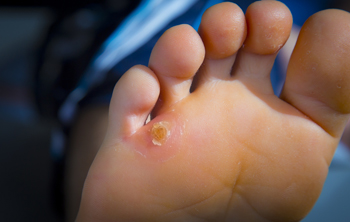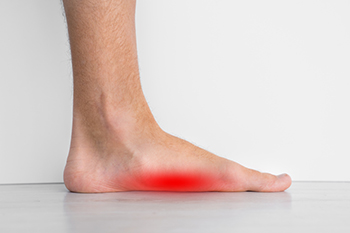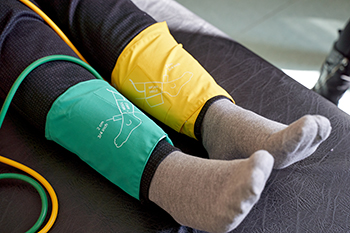Items filtered by date: February 2024
Child and Adolescent Heel Pain May Indicate Sever’s Disease

Sever's disease, also known as calcaneal apophysitis, is a common ailment among adolescents, particularly those engaged in active pursuits, like sports. This condition occurs when the growth plate at the back of the heel, where the Achilles tendon attaches, becomes inflamed. Typically affecting children aged 8 to 15 during growth spurts, Sever's disease is often linked to the rapid skeletal development that outpaces the tightening of the Achilles tendon. The repetitive stress on the growth plate from physical activities can lead to discomfort, swelling, and pain at the heel. If your active child has heel pain, it is suggested that you visit a chiropodist who can confirm a Sever’s disease diagnosis, and offer correct treatment methods.
Sever’s disease typically affects young children and teenagers. If your child complains of foot pain, please consult with one of the chiropodists from Complete Family Footcare & Therapy. Our clinicians will assess your condition and provide you with quality foot and ankle treatment.
What Is Sever’s Disease?
Sever’s disease, also known as calcaneal apophysitis, is an inflammation of the growth plate in the heel bone. It is typically caused by overuse due to repetitive activities such as running, jumping, and playing certain sports. This condition most frequently affects children between the ages of 8 and 14.
Symptoms
Symptoms of Sever’s disease include:
Pain in the back or bottom of the heel
Pain when the sides of the heel are squeezed
Limping or walking on tiptoes to avoid putting pressure on the heel
Difficulty running, jumping, or participating in usual activities
Fatigue
Diagnosis
Sever’s disease is diagnosed by taking a thorough medical history and performing a physical examination. Imaging studies, such as an X-ray, can help rule out other injuries like a fracture.
Treatment
Sever’s disease typically heals without any long-term complications. Treatment involves resting the affected foot by reducing typical activities, wearing orthotics to support the foot, immobilizing the affected foot, taking medications to reduce pain and inflammation, and stretching the foot.
If you have any questions, please feel free to contact our offices located in . We offer the newest diagnostic and treatment technologies for all your foot care needs.
Exploring the Reasons Behind Corns on the Feet

Corns are patches of thickened skin that develop on the feet, and often raise questions about their underlying causes. These small, round areas of hardened skin typically form in response to friction or pressure, commonly occurring on the toes or the sides of the feet. Wearing ill-fitting footwear, such as shoes that are too tight or have narrow toe boxes, is a primary culprit behind corn formation. The constant rubbing and irritation from shoes can lead to the buildup of dead skin cells, resulting in the formation of corns. Additionally, foot deformities such as hammertoes or bunions can exacerbate the problem by creating areas of increased pressure. High heels, which force the toes into unnatural positions, are notorious for causing corns as well. Understanding the reasons behind corns on the feet underscores the importance of proper footwear choices and proactive foot care practices. If you have corns on your feet, it is suggested that you consult a chiropodist who can successfully remove them, and offer effective prevention strategies.
Corns are small bumps or dry, hardened skin that can arise on the feet, usually in response to friction. Corns can be asymptomatic, or they can be uncomfortable or painful. If you have corns that are bothering you, please consult with one of the chiropodists from Complete Family Footcare & Therapy. Our clinicians can help you maintain the health of your lower limbs and your mobility.
There are three types of corns:
Hard corns
Often occur on the tops of toes
Feature a hard core surrounded by dry, irritated skin
Can be painful
Soft corns
Often occur in between the toes
Soft due to constant exposure to sweat
Can be painful
Seed corns
Tiny
Often occur on the soles of the feet
Usually asymptomatic
Corns can be prevented by wearing shoes that fit properly. They are typically benign and don’t require medical treatment. However, if your corns are causing you pain or discomfort, don’t hesitate to reach out to a chiropodist near you for treatment options. If you have any questions, please feel free to contact our offices located in . We offer the newest diagnostic and treatment technologies for all your foot care needs.
The Definition of Flat Feet

Flat feet, medically referred to as pes planus, is a condition where the arches of the feet collapse, causing the entire sole to make contact with the ground. This anatomical variation can occur due to a variety of factors, including genetics, weak arches, or the weakening of the supportive tissues in the feet over time. While some individuals with flat feet may experience no symptoms or discomfort, others may encounter issues such as pain or fatigue in the feet, ankles, or lower legs, particularly after standing or walking for extended periods. Flat feet can also contribute to problems with posture and alignment, potentially leading to knee, hip, or back pain. Understanding the definition of flat feet is essential for individuals to recognize the condition and seek appropriate care. There are methods that can be implemented which may bring relief to patients who are experiencing discomfort from flat feet. If you have this condition and are seeking relief, it is suggested that you contact a chiropodist.
Flat feet are a common foot condition. If you are experiencing pain or discomfort due to flat feet, please consult with one of the chiropodists from Complete Family Footcare & Therapy. Our clinicians will assess your condition and provide you with quality foot and ankle treatment.
What Are Flat Feet?
Flat feet are feet that do not have a well-defined arch in the middle of the sole of the foot. Flat feet may be flexible or rigid. Flexible flat feet have an arch when there is no pressure put on the foot, such as when one is sitting, but the arch disappears upon standing. Rigid flat feet lack an arch regardless of whether one is standing or not.
Causes
Flat feet can be present from birth or acquired over time due to a weakening of the ligaments in the arch. Sometimes flat feet are caused by illnesses, injuries, or pregnancy.
Symptoms
Flat feet often cause no noticeable symptoms. However, some people may experience pain and discomfort due to their flat feet.
Symptoms associated with flat feet include:
Pain in the arch, heel, ankle, or along the outside of the foot
Overpronation of the foot
Shin splints
Aching or fatigue in the feet or legs
Pain in the knees, hips, or lower back
Treatment
In cases where flat feet cause symptoms, there are various treatments available. Wearing orthotic inserts in your shoes to provide more arch support, performing stretches, and taking medications may improve your symptoms. If you are overweight, losing weight can help relieve pressure on the feet. In severe cases, surgery may be considered.
If you have any questions, please feel free to contact our offices located in . We offer the newest diagnostic and treatment technologies for all your foot care needs.
Complications of Peripheral Artery Disease

Peripheral artery disease, or PAD, predominantly affects the arteries supplying blood to the legs and feet, leading to various symptoms and complications related to these areas. Symptoms include painful leg muscle cramping during physical activities, particularly walking or climbing stairs, and is sometimes referred to as intermittent claudication. Other signs encompass coldness in the lower legs or feet, skin color changes, leg pain at rest, hair loss, dry and pale skin, bluish feet, brittle toenails, numbness, muscle wasting, and non-healing leg ulcers. PAD is primarily caused by fatty deposits accumulating in the arteries, known as atherosclerosis, with contributing factors including smoking, diabetes, high-fat diet, elevated cholesterol, high blood pressure, and advancing age. Seeking podiatric attention for leg pain is essential, and urgent consultation is warranted for severe symptoms, such as sudden foot pain, numbness, or bluish toes. Diagnosis involves medical evaluation, pulse checks, and various tests. Management includes lifestyle changes, medications, and, in severe cases, surgery. If you know you have peripheral artery disease or have symptoms as described above, it is suggested that you make an appointment with a chiropodist for a diagnosis and treatment for your specific situation.
Peripheral artery disease (PAD) is a condition that causes poor circulation in the lower limbs. If you have PAD, please consult with one of the chiropodists from Complete Family Footcare & Therapy. Our clinicians can help you maintain the health of your lower limbs and your mobility.
What is peripheral artery disease?
Peripheral artery disease is characterized by reduced blood flow to the lower limbs. This occurs due to a buildup of a fatty substance called plaque in the arteries. The plaque causes the arteries to become narrow and harden, which makes it difficult for blood to get to the lower limbs. Without adequate blood flow, the tissues of the legs, ankles, and feet do not get enough oxygen and nutrients to function properly, which can lead to various symptoms as the condition progresses. Having poor circulation also increases your risk of cardiovascular events, such as heart attacks and strokes.
Symptoms
In its initial stages, PAD is often asymptomatic. If symptoms do arise, they often include:
Muscle cramps
Weakness
Fatigue
Pain that gets worse with physical activity
Balance problems
Difficulty walking
Diagnosis
PAD can be diagnosed through a thorough physical examination, medical history, and vascular testing. There are many simple, non-invasive tests that your chiropodist can use to determine your risk of having PAD. These include the ankle-brachial index (ABI) test and Doppler ultrasounds.
Treatment
Treatments for PAD focus on lifestyle changes and medication management to lessen symptoms and prevent heart attacks and strokes. Your chiropodist may suggest various foot and ankle exercises to increase the strength and flexibility of your feet and ankles, boost circulation, and improve mobility. They may also suggest routine visits to monitor and maintain the health of your feet since poor circulation can lead to a variety of foot and ankle complications.
If you have any questions, please feel free to contact our offices located in . We offer the newest diagnostic and treatment technologies for all your foot care needs.

